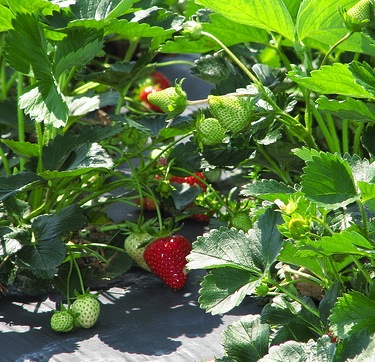 Photo: versageekIn a recent article, the SF-based New York Times affiliate The Bay Citizen reported on a significant gap in California’s organic strawberry industry: Most certified-organic strawberries do not start out that way.
Photo: versageekIn a recent article, the SF-based New York Times affiliate The Bay Citizen reported on a significant gap in California’s organic strawberry industry: Most certified-organic strawberries do not start out that way.
While there are a number of farms using organic practices to raise the berries (most keep them in the ground from one to two years), they must rely on commercial-scale plant nurseries for young plants. By the time those plants, or “starts” as they’re called, make it to the farm, they have usually gone through an entire year’s growing cycle in the nursery.
If it’s a conventional nursery, that means the soil they’re grown in has been fumigated with a whole array of chemicals, including methyl bromide, a soil sterilizer and pesticide known to be depleting the ozone layer.
(As an aside, what The Bay Citizen didn’t mention is that methyl bromide is thankfully being phased out — but the EPA and the state of California are allowing the use of an even more toxic chemical, methyl iodide, instead. We’re saving the climate at the expense of farmworkers’ and their families’ health.)
The Bay Citizen article introduces readers to James Rickert, the owner of a nursery that provided organic strawberry starts until he closed up shop in early 2010:
He thought he could easily sell the plants for $100 per thousand, or $8 more than the price of conventional plants. But the market never materialized.
Swanton Berry Farm’s Jim Cochran (incidentally, the first organic strawberry farmer in California) bought the organic starts, but since profit margins on most farms are already razor thin, almost everyone else opted to save the $8.
The question The Bay Citizen piece raises is not whether those farmers should have sprung for the organic starts, but why they weren’t required to. The answer lies within a loophole in the USDA’s National Organic Program (NOP), which allows for conventionally grown seed or starters when organic versions are not “commercially available.”
The occasion for the article was a letter penned by Cochran, Rickert, and Larry Jacobs (of Del Cabo tomato fame), with the help of Pesticide Action Network. In it, they ask the NOP to stop the abuse of the “commercially available” loophole and enforce the organic starts rule more aggressively.
If this happens, it’s possible that another nursery will make a go at providing organic starts, but until they’re commercially available farmers will still have a loophole — no matter how strict the law appears.
For organic growers, it’s a needle-threading challenge reminiscent of the debate over genetically modified seed contamination and organic grains. Perhaps out of a sense of fairness, a USDA official recently suggested that farmers would not lose their organic certification if their fields were inadvertently contaminated with GMO seeds through wind or bee pollination. Of course, that means that some organic products may test positive for genetically modified ingredients, the absence of which is one of the core “guarantees” organic is supposed to provide.
We live in a sadly complicated if not outright contaminated food environment. That reality leads to equally complicated rules, which are in turn both hard to meet and open to manipulation. Just look at the common practice of the intentional mislabeling of seafood.
So where does the strawberry situation fall? In a grey area, unfortunately: The fumigants aren’t particularly a risk to consumers — there’s no evidence of residue on the plants, and certainly not on the fruit that’s grown organically. They are, however, very dangerous to the people who use them, as well as to the communities in which they are used.
The unfortunate thing about the NYT/Bay Citizen article — which does a great job of reporting on the issue overall — is the overblown opening paragraph. One can almost hear it being read in a dramatic, movie-trailer voiceover style:
“Organic-produce buyers who think they are striking a blow against a chemical-heavy industrial food system may be surprised when it comes to one of California’s signature fruits: those ‘organic’ strawberries that overflow from baskets at local farmers’ markets are not nearly as organic as they may think.” [italics ours]
This story will no doubt make consumers think twice about what it takes to grow organic strawberries, as well as other fruit. The flip side of succumbing to the temptation to over-dramatize legitimate concerns such as these is that they are often warped and amplified by paid skeptics and trade groups like the U.S. Farmers & Ranchers Alliance.
Rather than create more fodder for larger efforts working to diminish the value of food that is by and large still much less ecologically destructive and resource-intensive than the norm, let’s stick to what we know.
After all, every year those strawberry plants spend on an organic farm translates to a significant decrease in the amount of conventional pesticides, fumigants, and fertilizers put to use. That may not sound like much to celebrate, but it’s nothing to ignore either.
Note: This article was edited to reflect the fact that Pesticide Action Network did not sign onto the letter.


